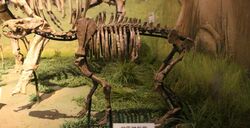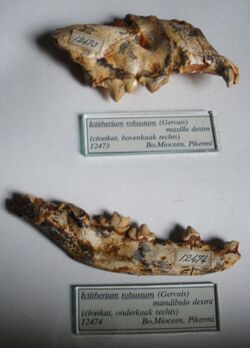Biology:Ictitherium
| Ictitherium | |
|---|---|

| |
| Skeletal mount, Tianjin Natural History Museum | |
| Scientific classification | |
| Domain: | Eukaryota |
| Kingdom: | Animalia |
| Phylum: | Chordata |
| Class: | Mammalia |
| Order: | Carnivora |
| Suborder: | Feliformia |
| Family: | Hyaenidae |
| Subfamily: | †Ictitheriinae |
| Genus: | †Ictitherium |
| Species | |
| |
Ictitherium (meaning "weasel beast") is an extinct genus belonging to the family Hyaenidae and the subfamily Ictitheriinae erected by Trouessart in 1897. Ictitherium species were endemic to Eurasia and Africa during the Middle Miocene through the Early Pliocene (12.7—5.3 mya) and existed approximately 7.4 million years.[1]
Ictitherium were around 1.2 metres (4 ft) long, and looked more like civets than modern hyenas, possessing a long body with short legs and a possibly short tail. It is speculated that I. viverrinum ate plants as well as medium-small mammals and birds.[2] Ictitherium was a very successful and abundant genus, with multiple fossils often being found at a single site.[3] Possibly, this early hyena genus lived in packs and had a social order, much like its modern descendants.[citation needed]
References
- ↑ Paleobiology Database: Ictitherium basic info.
- ↑ "Carnivoran Dietary Adaptations: A Multiproxy Study on the Feeding Ecology of the Fossil Carnivorans of Greece". 14 Feb 2021. https://pergamos.lib.uoa.gr/uoa/dl/frontend/file/lib/default/data/2888228/theFile.
- ↑ Palmer, D., ed (1999). The Marshall Illustrated Encyclopedia of Dinosaurs and Prehistoric Animals. London: Marshall Editions. p. 221. ISBN 1-84028-152-9.
Wikidata ☰ Q135599 entry
 |


